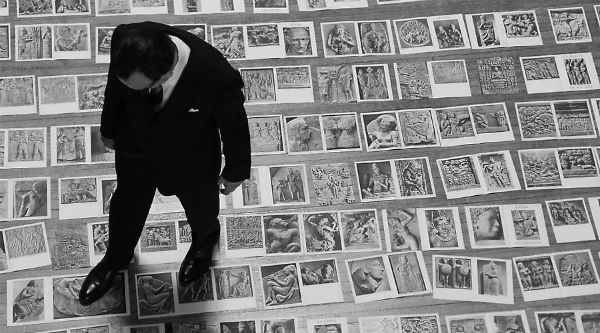The rediscovery of primitive painting and sculpture helped modern eyes to see that art had a deeper mission than visual beauty…
The story goes that the painter Theodore Rousseau once set up his easel before a tree. A peasant walked up to him. “Why do you paint this oak tree,” asked the peasant, “when it is already there?” The answers that different painters might give to this excellent question would categorize their consciously or unconsciously held aesthetic theories. All the conceivable answers share the notion that art is meant to express beauty and to delight the senses of the mind. Most share the view that the artist paints by his own volition. Many- by no means all- share the view that art is primarily concerned with reflecting the physical world of shape and color, filtered through the artist’s personal vision. With all these propositions Andre Malraux disagreed.

—The concept of the ‘museum without walls’ was first coined by André Malraux in 1947. He then referred to it as Le Musee imaginaire, which translated means: the imaginary museum. Malraux realized that it was now possible to for works of art to go beyond the museum by the means of photography. The effect this has on the work of art is that it looses its original meaning and significance as well as all textuality specific to the material of the artwork.
Malraux accepted the change that photography brought and saw it usefull. Yet he saw photography of art only as legitimate when used in the service of art.—http://lsphoto.de/ccblog/2010/11/23/museum-without-walls-and-internet/
In Malraux’s view, beauty and delight are not the chief aims of art; the artist is not a being free to “express himself” but an instrument of a more or less mysterious force; and the aim of the true artist is not to paint the visible but the invisible world. These are some of the aesthetic assumptions that underlined Malraux’s Metamorphosis of the Gods.
ADDENDUM:
(see link at end)…Hither to the connoisseur duly visited the Louvre and some subsidiary galleries, and memorized what he saw, as best he could. We, however, have far more great works available to refresh our memories than those which even the greatest of museums could bring together. For a “Museum Without walls” is coming into being, and . . . it will carry infinitely farther that revelation of the world of art, limited perforce, which the “real” museums offer us within our walls. André Malraux, The Voices of Silence, 1953.Read More:http://www.msdm.org.uk/texts/without_walls.html

— Musée Imaginaire, translated as Museum Without Walls, written in 1947, still resonates today. Great art, he wrote, made accessible to all through reproductions in books, is liberated from the time, place, and history in which they are usually confined by museum categories. Removed from historical context, they can be rearranged in the mind according to aesthetic or philosophical qualities. Malraux drew on the thoughts of Henri Focillon, in La Vie des Formes / The Life of Forms in Art, in suggesting a kind of universal consciousness that all great art responds to. In this way it has the power to transcend the bitter partisan divisions that Malraux knew so well.
Malraux recognized that while taking the great works of art outside of museums liberated them from history, it also threatened to homogenize them into reproducible formats. Everything from the gigantic Sphinx to medieval miniatures assumes the same dimensions in art books, obliterating the effects of scale.—Read More:http://www.kamprint.com/views/?p=567 image:http://blogs.artinfo.com/artintheair/2012/08/30/artist-dennis-adams-remakes-andre-malraux’s-“imaginary-museum”-in-a-new-video/
…“The human mind invents its “Puss ‘n Boots” and coaches changing-into-pumpkins-at-midnight because neither the theist nor the atheist is satisfied with appearances.”
— Andre Malraux, Anti-Memoirs …“Man is not what he thinks he is, he is what he hides.”…“What is man? A miserable little pile of secrets.” — Andre Malraux








 COMMENTS
COMMENTS



